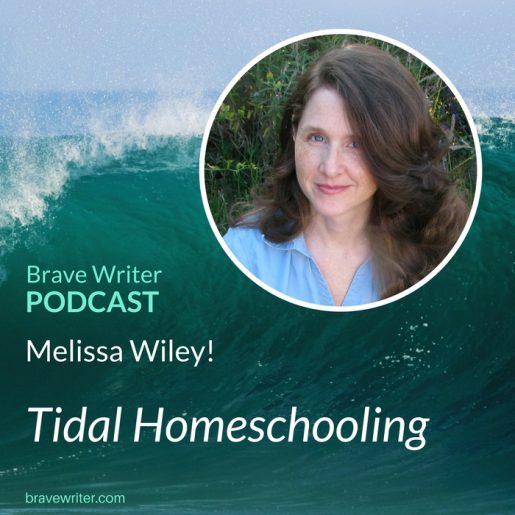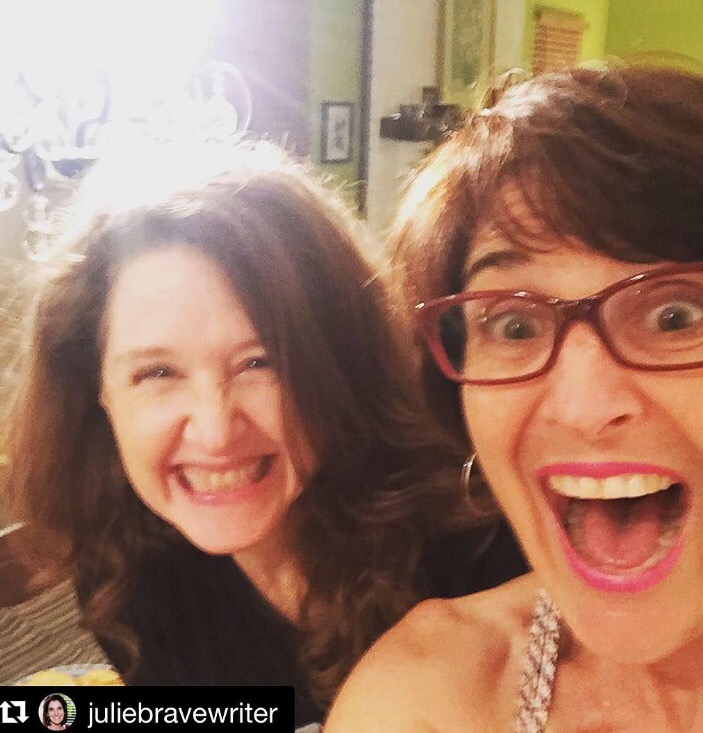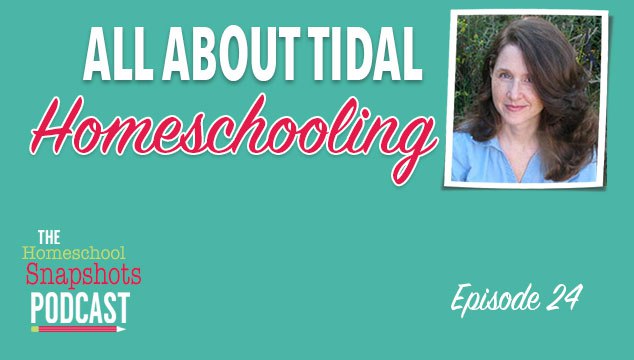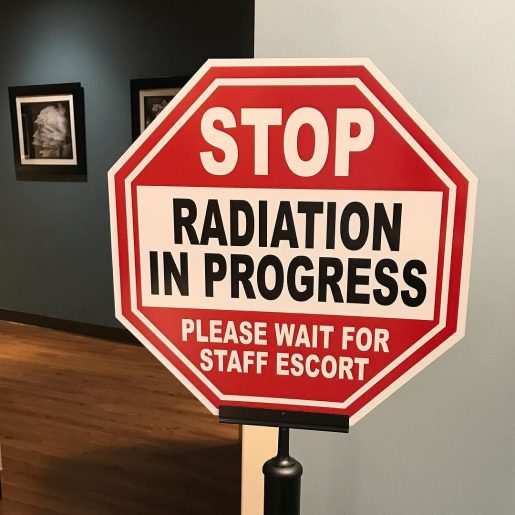
The sign that greets me outside the treatment room is ominous, and in context the words are sobering. But as I lie there on the table—for only a few minutes; the procedure is beautifully streamlined—I think about the words on the sign and realize the core message is one worth embracing. Radiation in progress…in philosophical terms, it’s really only a stone’s throw from Education is an atmosphere, isn’t it?
***
I just went on a little stroll through my archives, looking for an atmosphere post to link to. I didn’t find the one I wanted, but this one popped up and gave me a few happy pangs: This First Day, about Rilla’s first day of High Tide back in (gulp) 2012. The timing pierces, because today is S’s first day of school and that means the tide is shifting for the rest of us, too. This was a good passage for me to revisit this morning.
I used to waffle about methodologies: was I a Charlotte Mason homeschooler? An unschooler? Something in between—eclectic, perhaps? But it was all just groping for a label—and not even a label for my kids; it was about how to characterize myself in conversations with other homeschoolers, so that we might better understand one another. All the while, my kids and I went on simply doing what worked for us. If something stopped working, we did something else for a while—usually this has meant facilitating a child’s need to immerse deeply into a single passion or pursuit. I grok that; it’s how I love to learn, too. This blog is a chronicle of my own sudden immersions, some of them finite, some recurring at intervals: breadbaking, gardening, sewing, Irish pennywhistle, British period drama…it’s a long list. My kids have lists of their own, each one different, some interests overlapping.
Always, always, after one of these immersions, the diver comes up for air eventually. And there’s a restlessness, a pacing at loose ends, that has, for us, always been cured by a return to morning lesson time. Rose has told me she likes having the structure there to push against: knowing there are things she is expected to do fills her with ideas for things she longs to do. One of my jobs is to keep ears open for the longings, and drop resources and opportunities in her path to help her realize them. I love that part of the job.
After this summer’s upheaval, I’m ready for a return to some of the old rhythms that have served us well for so long. Of course, everything is constantly remaking itself, and the ‘old rhythms’ are overlain with new melodies.
***
Addendum: here’s another 2012 post that turned up and gave me a smile (and a pang) this morning.
This one’s for the curriculum-junkie homeschooling mothers of 2002. I’m going to try not to think about the boatload of books and things we left behind in San Diego—it’s time to go shop my shelves and rediscover the treasures we did bring with us. We made a lot of packing decisions in a tearing hurry and I’ve had moments of wishing I hadn’t been quite so ruthless in the purge. But we still have shelves bursting with literary riches, and my job this morning is to stock the living-room shelves with a few dozen gems. And where’s the giant world map, Huck wants to know?
January 12, 2017 @ 6:24 am | Filed under:
Books 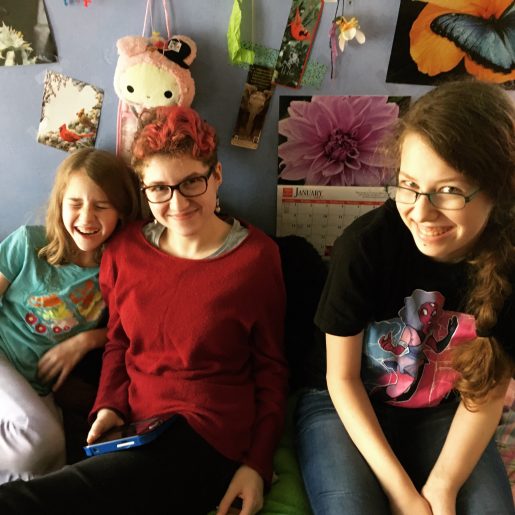
1.
Picture books:
Ah Ha! by Jeff Mack. Chronicle Books. This deceptively simple story is an absolute hoot. The only text in the whole book are variations on “Ah ha!” and “Ahh!” Ah ha! A little boy catches a frog. Ahh, the frog escapes from the jar. Ah ha! Right into the mouth of a predator. Ahh! He gets away again. And so on. For beginning readers, this is about as easy as it gets—you can read a whole book with just two sounds. For kids a bit older, like mine, it’s a fun exploration of inflection. How many shades of meaning can you infuse into those two simple syllables?
When Moon Fell Down by Linda Smith, illustrated by Kathryn Brown. HarperCollins. I’m sad to see this lovely book has gone out of print already. It’s been in regular circulation around here since my former Little House editor—also its editor—sent us a copy many, er, moons ago. Moon falls out of the sky one night, meets an amiable cow, and takes her along on an adventure around town. My favorite part is Moon’s discovery of a hidden side to things he has heretofore only seen from above—shop windows and horses’ knees, for example.




2.
High tide read-alouds:
Story of the World Volume 3: Early Modern Times by Susan Wise Bauer. Rilla, Huck, and I are just beginning this tome this week. I’ll admit Chapter 1 left them a little befuddled. It’s presented in a framing sequence several layers deep: imagine you’re a traveler who’s been all over the known world having adventures; it’s 1600 and there are these two kings you’re going to learn about, but first let’s back up to 1500 to hear about a young man who wanted to be Emperor because of this other emperor several centuries earlier…whew! And at the end of the chapter, both my kids were disappointed because they’d wanted to hear more about that grizzled old two-toothed world traveler from the first paragraph, who never showed back up. Fortunately, I know the text will settle down soon and they’ll be hooked into the historical dramas. But I think they’d rather hear the tale of the seven-toed, two-toothed scurvy man who survived being bitten by a cobra and a water moccasin. (!)
Fifty Famous Stories Retold by James Baldwin. Oldie but goodie. My favorite way to introduce my small people to classic references like the Sword of Damocles, King Alfred and the cakes, and the famous Laconic “IF.” (Those links will take you to the Main Lesson Project, where you can read the stories for free.)
The Oxford Illustrated Book of American Children’s Poems, edited by Donald Hall.
“Can I keep playing Legos while you read, Mom?”
“Can you play with them quietly enough that you’ll be able to hear?” ”
“Yes, but I need to rummage for some certain pieces first.”
“Okay, you rummage. I’ll pick out some poems. Ooh, Macavity!”
[Fifteen-year-old looks up from her geometry, bursts into song.]






3.
My own queue:
I finished Cat’s Cradle. If you’ll forgive me for getting ultra-intellectual on you for a moment—that is one bananas book. 😉
I got so much, and most mud got so little.
I seem to be rereading two Nick Hornby essay collections at once—Housekeeping vs. The Dirt in print, and More Baths, Less Talking on Kindle. Also in this collection: The Polysyllabic Spree and Shakespeare Wrote for Money. Yes, I will almost certainly have to reread them all before this kick plays out.
One of my favorite aspects of these “Stuff I’m Reading” columns is that Hornby leads with lists of the books he bought that month, and the books he actually read.
“The seasoned reader, accustomed to the vicissitudes of a life spent accumulating books, can probably guess without checking that in any given month, the Books Bought and Books Read lists hardly overlap.”
And later:
“Surely we all occasionally buy books because of a daydream we’re having—a little fantasy about the people we might turn into one day, when our lives are different, quieter, more introspective, and when all the urgent reading, whatever that might be, has been done. We never arrive at that point, needless to say…”
And here he’s speaking to my rabbit-trailing, homeschooling heart:
“And so a lot of adult life—if your hunger and curiosity haven’t been squelched by your education—is learning to join up the dots that you didn’t even know were there.”
(All these quotes are from More Baths, which is more easily quotable simply because I have it on Kindle and can copy-paste from my “Your Highlights” page.)
Some enticing new titles landed on my Netgalley shelf this week, including a new-to-me reprint of a Madeleine L’Engle novel, Ilsa, which has been out of print for some sixty years and is being reissued by Open Road Media next month. More on that to come, surely. And I’ve received a copy of Maud, “a novel inspired by the life of L. M. Montgomery” by Melanie Fishbane, due out in April from Penguin. (Jen of Recreational Scholar expresses some ambivalent feelings about it in this post.)
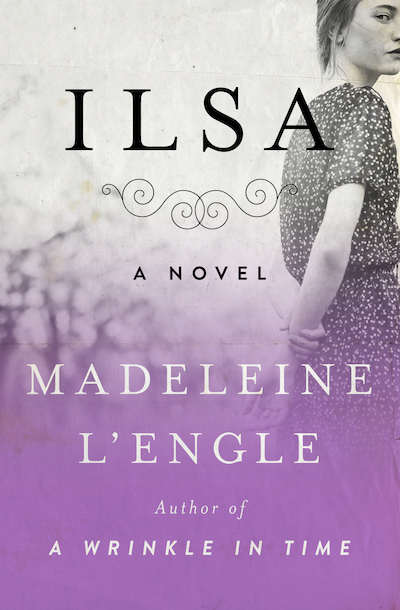


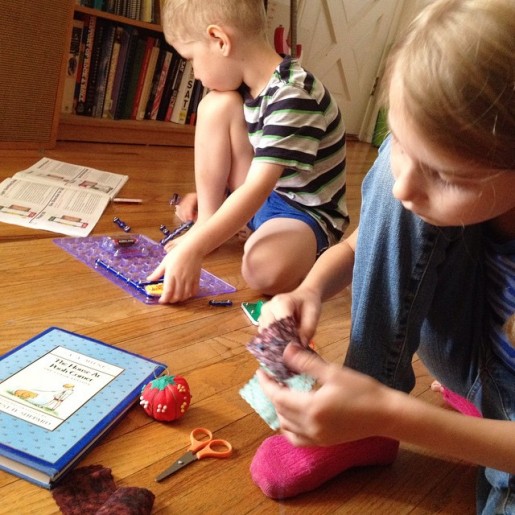
The other day I mentioned that I was putting together some shelves of books to use for Huck and Rilla this year. Huck is 6 1/2 and Rilla is 9, and according to the boxes I will have to check on the form I file in October, they are in the 1st and 4th grades respectively.
(Of course you know we have more of an Understood Betsy approach to grades around here.)
‘What’s the matter?’ asked the teacher, seeing her bewildered face.
‘Why–why,’ said Elizabeth Ann, ‘I don’t know what I am at all. If I’m second-grade arithmetic and seventh-grade reading and third-grade spelling, what grade am I?’
The teacher laughed. ‘You aren’t any grade at all, no matter where you are in school. You’re just yourself, aren’t you? What difference does it make what grade you’re in? And what’s the use of your reading little baby things too easy for you just because you don’t know your multiplication table?’
‘Well, for goodness’ sakes!’ ejaculated Elizabeth Ann, feeling very much as though somebody had stood her suddenly on her head.
I don’t think Rilla has any idea what grade she would be in if she went to school…my kids don’t usually pay attention to grade level until they reach an age—usually around 12 or 13—when they want an answer to the question that comes from just about every new adult they encounter.
But back to my booklists. I compiled these selections according to my patented, highly scientific method of Walking Around the House Grabbing Things Off Shelves™. These are books we already own, favorite tomes I have read with the older kids in the past but which my younger set haven’t yet heard or read—due in large part to the abundant inflow of new treasures that have come our way for review. (Oh you guys, I have so many good new books to share.)
I imagine there will be a lot of crossover: Huck will listen in on Rillabook readalouds and vice versa. Both collections also include a good many read-alone possibilities. If you’ve been reading Bonny Glen for a while, then you know that read-alouds are the core of my homeschooling method, especially in the younger years. (But continuing on, you know, into high school. We still read aloud together lots of history, science, and poetry.)
I know a lot of you are as addicted to booklists as I am, so my project this weekend is to type up these collections to share here on the blog. I hope to post them on Sunday or Monday. When they’re ready, I’ll update this post with links.
So what else does high tide look like in my house for ages 6 and 9?
In no particular order:
• Lots and lots of art, especially watercolor painting and Sculpey fun.
I keep watercolors handy on a shelf by the kitchen table for easy access. These days, the kids are also doing a lot with acrylic paints—I caught a sale at Michael’s when those little Folk Art bottles were three for a dollar. I grabbed a set of small plastic palettes (six for $2) and filled a jar with our older, more battered brushes. (We reserve the nicer brushes for watercolors.)
I’ve written about this before*, but for watercolor paper I use large sheets I bought in bulk a good many years ago, folded and torn into smaller sizes. And then cheap recycled paper for drawing. Plus everyone has a sketchbook to do whatever they want with.
About 15 years ago (!) I bought half a dozen scratch-and-dent whiteboard seconds from a discount site. We use these as painting boards. Not only do they protect the kitchen table from spatters, but they are large enough that I can stack them on toy blocks to save space while paintings dry.
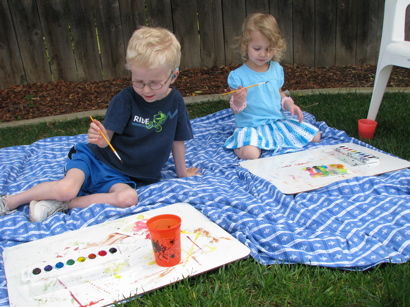
* In that 2009 post, I mentioned that for littles I use good paper and cheap paints. That was back when Rilla was three years old. ::sniff:: Nowadays we tend to experiment with artist-quality tube watercolors quite often, because that is what I myself am learning to paint with, and both Rilla and I are pretty addicted to color-mixing and the way certain pigments granulate on the paper. We still keep basic Crayola or Prang kids’ paint sets around, though, like the ones in the photo, because they’re quick and fun and easy and portable. They’re what the kids use for casual, everyday painting.
Kortney has been posting some wonderful resources for doing art projects with kids. And I have a list of my best suggestions in this post.
• Poetry every day
I pulled some of my favorite anthologies for this year’s Huck and Rilla shelves. They’re also in the room for a good bit of the poetry reading and discussion I do with the older kids. I work in lots of opportunities for low-pressure memorization (if you read the same poem out loud a few days or weeks in a row, before you know it, everyone has it down)—including my recent brainstorm to require Huck to learn a new poem by heart before he gets a new iPad app. 🙂
• Handwriting practice* with fun materials like dip pens, markerboards, or slates-and-chalk.
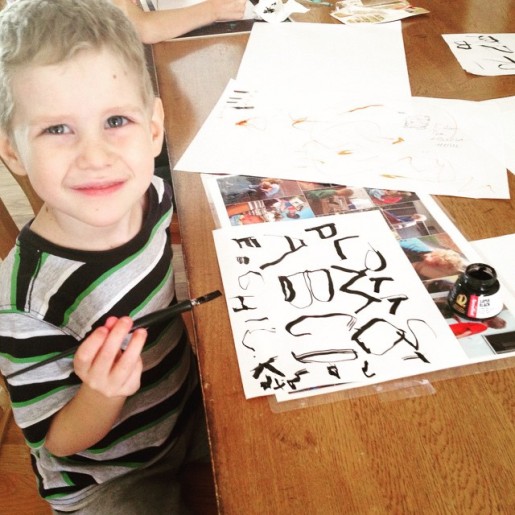
I asterisked practice because I need to qualify that term. I subscribe to the John Holt school of thought about the misleading way we often use the word practice. He argued that when you are doing what we call “practicing” piano, you are really playing piano and we ought to think of it like that. You are making music. When I am “practicing” drawing, I am actually drawing. Huck is learning to write. When he sits down with a marker or crayon and makes some letters, he is writing—not some separate intermediate activity that leads up to writing. I think that word “practice” can set up a feeling that what I’m doing right now isn’t real, it doesn’t count. But it all “counts.” If you’re doing it, it’s real. Another way of putting it is that writing letters to friends is a form of handwriting “practice.”
• For Rilla, a third year of group piano class
And yes, despite the above paragraph, you will from time to time hear me ask her if she has practiced yet today. 🙂
• Nature study and narration.
My old Charlotte Mason standbys. Re narration: casually for Huck, more deliberately and regularly for Rilla. All oral, still. We add written narration at age ten.
Nature study isn’t something we have to work at. Both Rilla and I enjoy adding new plants and bugs to our sketchbooks. You’ll see a fair number of nature-themed nonfiction on both booklists.
• A little bit of foreign language.
Beanie is ramping up her German studies this year. My younger set pick up whatever the older ones are working on, sponge-style.
• Math.
Via games, money, dice, and daily life for Huck; Math-U-See for Rilla. Works for us.
• Folk songs and other musical fun.
Including daddy’s guitar-playing. The recorders seem to have made a comeback around here, too, and Rose came home from her Colorado trip with a pair of ocarinas.
• Baking, sewing, Snap Circuits, and other hands-on pursuits.
Sometimes this is simply a part of daily life; in other cases we may undertake a special project, such as making clothes for a cloth doll with the Dress Up Bunch Club.
Beanie is venturing into candymaking this year and has already enlisted Huck, Rilla, and Wonderboy as helper-slash-tasters. Rose does quite a bit of baking—being one of those delightful people who love to bake but don’t much care to eat baked goods—and often includes younger sibs in the measuring, mixing, and bowl-licking stages.
• Games of all sorts.
Board games, word games, Wii games, iPad apps, you name it. Together or alone. And lots and lots of Minecraft.
• As much outdoor play as possible!
All the small fry on the block seem to congregate at my house in the afternoons: they know when my kids get their Wii time. 😉 Afterward, they troop outside to bike and scooter and make secret hideouts and chat with passing dogs and help Miss-Joanie-down-the-block rake leaves. (She’s a treasure. She keeps a stash of child-size yard tools in her garage! She saves all those little stickers and calendars and bookmarks that come in junk mail! She has cups labeled for all the kids on our street and sometimes mixes up fruit drinks to fill them with instead of water. Everyone should be so lucky as to grow up down the block from Miss Joanie.)
• What about history and science?
See above re: readalouds and narration. Lots of good stuff on our booklists. 🙂
And if I don’t stop gabbing and start compiling, these booklists are never going to get written. More later, my dears. Feel free to fire away with questions below, if you have any!


